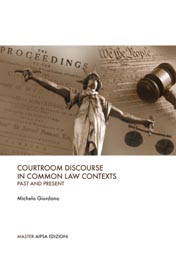
Courtroom Discorse in Common Law Contexts
Past and Present
Autore: Michela Giordano
Anno: 2016
Pagine: 218
ISBN: 978-88-98692-38-5
Prezzo: € 18,00
Formato: 16×23
Note: Foto di copertina di Manuela Giordano
#
#
#
Il libro
The importance of language in the study of courtroom trials has been comprehensively investigated from a series of diverse perspectives. Some of these perspectives are taken into consideration herein to carry out the exploration of various aspects of courtroom discourse, i.e. the witnesses’ testimonies, the transcripts of the proceedings, the particular features of questioning and turn-taking, along with matters related to courtroom interpreting and to the interaction and negotiation of different professional discourses (legal and medical) embedded in this institutional context. This book has been a long time in the making: it starter as a collection of independent papers and it draws together, along with the new material, different investigations of courtroom discourse in Common Law contexts previously presented or published in more highly specific contexts.
L’importanza della lingua nello studio dei processi nelle aule di tribunale di Common Law è stata ampiamente studiata da diverse prospettive. Alcune di queste prospettive sono prese in considerazione in questo testo al fine di esplorare i vari aspetti del linguaggio utilizzato nei tribunali, quali, ad esempio, le testimonianze, le trascrizioni del procedimento, le particolari caratteristiche dell’interrogatorio e dei turni di parola, insieme a questioni relative all’interpretazione della Corte e l’interazione e la negoziazione dei diversi linguaggi professionali (legale e medico) nel contesto istituzionale. Questo libro è iniziato come una raccolta di articoli indipendenti, alcuni pubblicati precedentemente in riviste accademiche specializzate, e poi, con l’aggiunta di nuove ricerche, è diventato un’analisi, anche diacronica e quantitativa, del linguaggio professionale legale nel contesto specifico di casi penali nei tribunali di Common Law, partendo da processi tenuti all’Old Bailey di Londra per arrivare a casi più recenti come quelli di Orenthal J. Simpson negli Stati Uniti e Oscar Pistorius in Sud Africa.
L’Indice / Contents
Introduction
1.The language of the courtroom
2. Overview of aims and contents
1. Witness testimony in the Old Bailey proceedings
1. Witness testimony as narrative
2. The Old Bailey Proceedings online: A historical source
3. Narratives in the courtroom: Primary and Secondary reality
4. Different categories of witnesses
5. The language of distance v the language of immediacy
6. Quoted dialogue in witness narratives
7. Powerful and powerless witnesses
2. Transcripts of trial proceedings
1. Transcripts as official written records of spoken discourse
2. Transcripts as genre
3. The decontextualization of written transcripts
4. Reporter’s comments in Primary and Secondary reality
5. The narrative mode v the paradigmatic mode
3. Medical discourse in the historical courtroom
1. Expert evidence at the Old Bailey
2. Medical experts in the historical courtroom
3. Medical jargon embedded in the legal context
4. Epistemic modality and evidentiality
5. Lay-professional discourse in an institutional context
4. The interaction of law and medicine in court
1. Expert testimony in modern Common Law courts
2. Professional talk in an institutionalized context
3. Experts’ contributions to direct and cross-examinations
4. Forms of adress: The title “Doctor” in court
5. Courtroom questioning
6. Construction and deconstruction: identity, credibility and power asymmetry
7. Lawyer v medical expert: A “complex dialogic framework”
5. The re-mediation of justice in post-colonial legal discourse
1. A different perspective: The courtroom drama
2. Rumpole of the Bailey: An attempt of popularization?
3. The courtroom drama genre
4. Intertextuality and parody
5. Visual symbols and irony
6. Metaphors and figurative language
7. The personification of justice
8. Mockery of the trial process and critique of colonialism
9. Courtroom drama: Law for lay people?
6. Court interpreting in multilingual contexts
1. Interpreting in the South African multilingual courtroom
2. A theoretical framework of court interpreting
3. The legal system and the “open justice” in South Africa
4. Linguistic diversity and court interpreting in South Africa
5. Witness testimony lost in mistranslation
6. A redefinition of the role of court interpreters
7. Metapragmatics in the courtroom
1. Metapragmatics and reflexivity
2. Metapragmatic Framing Strategies in courtroom interaction
3. The negotiation of professional boundaries
Conclusions
References



